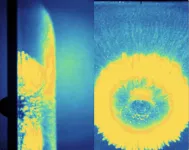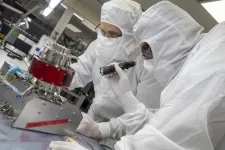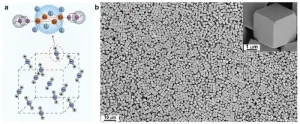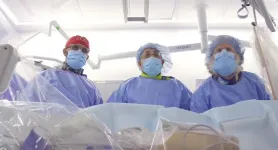(Press-News.org) PHILADELPHIA – A $40.5 million grant from the National Institute on Aging (NIA), part of the National Institutes of Health (NIH), will fund the Asian Cohort for Alzheimer’s Disease (ACAD) study at Penn Medicine and 15 other academic research centers across the United States and Canada. Led by Li-San Wang, PhD, the Peter C. Nowell, M.D. Professor of Pathology and Laboratory Medicine in the Perelman School of Medicine at the University of Pennsylvania, the project represents the first major Alzheimer’s disease genetics cohort for Asian Americans and Asian Canadians, populations currently underrepresented in Alzheimer’s disease research. The other principal investigators for the project are Gyungah Jun, PhD, at Boston University Chobanian & Avedisian School of Medicine, Van Ta Park, PhD, at the University of California, San Francisco (UCSF), and Helena Chui, PhD, at University of Southern California.
Since other national datasets and clinical trials for Alzheimer’s disease research have low representation from people of Asian ancestry – generally less than 3 percent, and as low as 0.5 percent– it’s unclear if those research findings are broadly applicable to this minority group. To find out, the ACAD is recruiting adults age 60 and older, with or without cognitive issues, from Chinese, Korean, and Vietnamese ancestry. Participants are asked to complete a lifestyle and demographic questionnaire, undergo a cognitive assessment, and provide a saliva and/or optional blood sample.
“Alzheimer’s disease is one of biggest health challenges of the 21st century, and while Asians are the fastest growing minority in both the U.S. and Canada, they are disproportionately underrepresented in Alzheimer’s disease research,” said Wang, who also serves as the co-lead of the Data Management and Statistical Core at the Penn Alzheimer’s Disease Research Center and a member of the Institute on Aging at Penn. “This is a very ambitious project because we need to gather a critical mass of data on lifestyle and genetic risk factors to have enough statistical power to understand causes of the disease and strategies for treatment that may be specific to these Asian populations in the U.S. and Canada.”
Researchers will analyze the genetic data from the samples to identify risk variants in the Asian American and Asian Canadian population, compared to other populations and to those living in Asia. Based on these analyses, their goal is to develop blood biomarker benchmarks and a polygenic risk score model to measure the risk for Alzheimer’s disease specifically among Asian Americans and Asian Canadians. They will also examine non-genetic biomarkers in combination with lifestyle and clinical information to look for clues to other contributing factors to Alzheimer’s disease. The researchers plan to continue to seek collaborations to expand ACAD and follow up on the participants’ health as they age to obtain a clearer picture of Alzheimer’s disease progression.
The grant builds on a two-year, NIA-funded pilot grant awarded in September 2020 to assess the feasibility of the ACAD study design. As of May 2023, more than 1,800 individuals have joined the interest list for the study, with 713 formally consented to enroll. The goal of the new grant is to expand enrollment and recruit at least 5,000 participants over five years.
“We want to understand more about the needs of Asian Americans and Asian Canadians, engage them, and help them understand the disease, in an effort to destigmatize Alzheimer’s disease within these communities,” Wang said. “A major priority of this project is to help the community – we’re not just going in and taking samples. The response during the pilot phase was incredible excitement to participate, which reinforced why we’re doing this and the need for health equity in Alzheimer’s disease research.”
The research team engaged community leaders to learn how to best reach local Asian communities in each of the nine recruitment sites, located in cities with large Chinese, Korean, and/or Vietnamese populations. By leveraging existing relationships and infrastructure and using community-based participatory research principles, the team aims to build trust, raise awareness and overcome potential barriers to participation, including language. A crucial part of the study involves training bilingual staff who can communicate with interested participants in their preferred language and help ensure that the outreach materials and strategies are designed to effectively reach older adults with Chinese, Korean or Vietnamese heritage.
The research team includes international leaders in Alzheimer’s disease, genetics, and epidemiology, and experts who have devoted their careers to studying the health of Asians in the U.S. and Canada, as well as community partners and early-career scientists invested in contributing to healthy equity research. Penn investigators include Tiffany Chow, MD, an adjunct professor, and Gerard Schellenberg, PhD, a professor, both of Pathology and Laboratory Medicine, Mingyao Li, PhD, a professor of Biostatistics, Epidemiology, and Informatics, Wan-Ping Lee, PhD, and Fanny Yuk Yee Leung, PhD, both research assistant professors of Pathology and Laboratory Medicine, and Pei-Chuan Ho, PhD, a research associate in Pathology and Laboratory Medicine. Other participating institutions include University of British Columbia, University of California San Diego, University of California Irvine, Columbia University, Englewood Health, Indiana University, New York University's Rory Meyers College of Nursing, Icahn School of Medicine at Mount Sinai, Stanford University, Southern California Eye Institute, University of Toronto, University of Washington, and Brigham and Women’s Hospital.
The project is supported by NIA (R56AG069130 and U19AG079774). The content is solely the responsibility of the authors and does not necessarily represent the official views of NIA or the broader NIH. Visit acadstudy.org to learn more.
###
Penn Medicine is one of the world’s leading academic medical centers, dedicated to the related missions of medical education, biomedical research, excellence in patient care, and community service. The organization consists of the University of Pennsylvania Health System and Penn’s Raymond and Ruth Perelman School of Medicine, founded in 1765 as the nation’s first medical school.
The Perelman School of Medicine is consistently among the nation's top recipients of funding from the National Institutes of Health, with $550 million awarded in the 2022 fiscal year. Home to a proud history of “firsts” in medicine, Penn Medicine teams have pioneered discoveries and innovations that have shaped modern medicine, including recent breakthroughs such as CAR T cell therapy for cancer and the mRNA technology used in COVID-19 vaccines.
The University of Pennsylvania Health System’s patient care facilities stretch from the Susquehanna River in Pennsylvania to the New Jersey shore. These include the Hospital of the University of Pennsylvania, Penn Presbyterian Medical Center, Chester County Hospital, Lancaster General Health, Penn Medicine Princeton Health, and Pennsylvania Hospital—the nation’s first hospital, founded in 1751. Additional facilities and enterprises include Good Shepherd Penn Partners, Penn Medicine at Home, Lancaster Behavioral Health Hospital, and Princeton House Behavioral Health, among others.
Penn Medicine is an $11.1 billion enterprise powered by more than 49,000 talented faculty and staff.
END
Moral values such as purity and loyalty are often linked with hateful language, according to a study. Scholars in the field of Natural Language Processing (NLP) have in recent years focused on improving the automated detection of hate speech so such language can be removed from online spaces. But some scholars have argued that mere detection is not a real solution—that NLP can and should be used to investigate the roots of hateful language. Morteza Dehghani and colleagues conducted three studies of hateful language, looking at speeches and texts written by leaders of the Nazi party between 1933 and 1945, hateful slurs ...
An experimental study explores the visible impact flash created by high velocity impacts. Impacts by debris and meteoroids pose a significant threat to satellites, space probes, and hypersonic craft. Such high-velocity impacts create a brief, intense burst of light, known as an impact flash, which contains information about both the target and the impactor. Gary Simpson, K.T. Ramesh, and colleagues explored the impact flash by shooting stainless steel spheres into an aluminum alloy plate, at a speed of three kilometers per second — about 6,700 miles per hour, or more than nine times the speed of sound. The resulting impact flashes were photographed ...
SAN ANTONIO — July 11, 2023 —Southwest Research Institute has delivered a plasma spectrometer for integration into a lunar lander as part of NASA’s Lunar Vertex investigation, scheduled to commence next year. The target site is the Reiner Gamma region on the Moon’s nearside, a mysterious area known to have a local magnetic field. The SwRI-developed Magnetic Anomaly Plasma Spectrometer (MAPS) will study the interaction of the solar wind with surface materials on the Moon, aiming to understand the origin of the sinuous patterns of ...
Scintillators are optical materials that emit low-energy ultraviolet and visible photons in response to ionizing radiation such as X-rays and gamma rays. This property makes scintillating materials useful for applications like non-destructive testing, X-ray astronomy, security inspection, and medical imaging.
In a recently published paper in Light Science & Applications, Professor Xiaowang Liu and Academician Wei Huang, along with their team from the Institute of Flexible Electronics at Northwestern Polytechnical University, ...
DALLAS, July 11, 2023 — Two dedicated volunteers have reached a prestigious milestone with the American Heart Association, the world’s leading nonprofit organization devoted to a world of healthier lives for all, for their personal passion and commitment to advance women’s heart health.
For the third year, changemakers across the country were nominated to join the American Heart Association’s Woman of Impact and Teen of Impact® campaigns. Aligning with the Go Red for Women® movement, the Association’s signature ...
The Xerces Blue butterfly (Glaucopsyche xerces) was native to the coastal dunes of San Francisco, in the United States. As the city grew, much of the butterfly’s habitat was destroyed and its population was relegated to Golden Gate National Park. Its wings were a deep iridescent blue, with characteristic white spots on the ventral side. The last surviving specimens of the species were found in 1941, by entomologist W. Harry Lange. It is considered the first insect species to have become extinct in historical times. Its disappearance has made it a global icon of anthropogenic extinction, to ...
Washington, D.C. – Bacteria found in 74 kitchens spread among 5 European countries were mostly harmless according to new research published in Applied and Environmental Microbiology, a journal of the American Society for Microbiology.
“We have previously found considerable variations in kitchen standards, food preparation practices, and cleaning regimes between France, Norway, Portugal, Romania, and Hungary,” said Birgitte Moen, Ph.D., Scientist—Department of Food Safety and Quality, Nofima—Norwegian Institute of Food, Fisheries, and Aquaculture Research, Ås, Norway.
In ...
The aim is to maximize impact by turning to the combined talent and insight of the broader international neuroscience community.
SEATTLE — July 11, 2023 — Today, scientists from the Allen Institute for Neural Dynamics, a division of the Allen Institute, launched the world’s first completely open- and crowd-sourced neuroscience experiment—inviting researchers from around the world to publicly design a shared experiment that will run on the Allen Brain Observatory, as part of the Institute’s OpenScope program. Experiments will probe ...
Biologists attempting to conserve and restore denuded environments are limited by their scant knowledge of what those environments looked like before the arrival of humans. This is especially true of coastal ecosystems, many of which had already been drastically altered by pollution and overharvesting hundreds of years before scientists began monitoring them.
According to a new study published in the journal PeerJ, a faithful analogue of modern marine ecosystems lies just beneath the surface. Building on more than 20 years of conservation paleobiology, the results suggest that fossils of various marine groups — including worms, mollusks, crabs and sea urchins — are ...
Click here to watch a video on the new Cath Lab
Mount Sinai Queens today announced the opening of a new cardiac catheterization lab that will provide rapid and comprehensive care to hundreds of heart patients every year for life-threatening emergencies and scheduled cardiac procedures. The first cardiac catheterization lab in Astoria, it will transform treatment for patients in the growing communities of western Queens by vastly improving access to cardiac care in the borough and beyond.
Atul Kukar, DO, has been named the Director of the Mount Sinai Queens Catheterization Lab and leads a team of 14 specialists including interventional cardiologists, nurses, and technicians.
“Our ...




